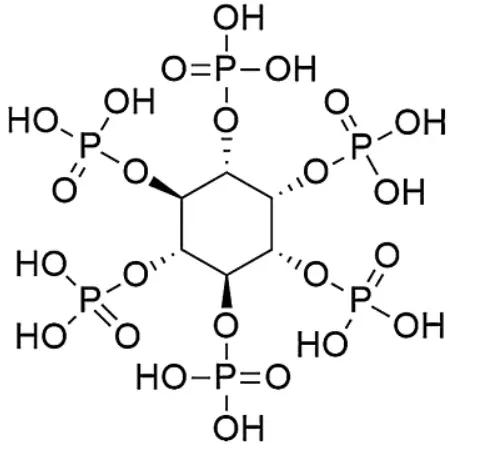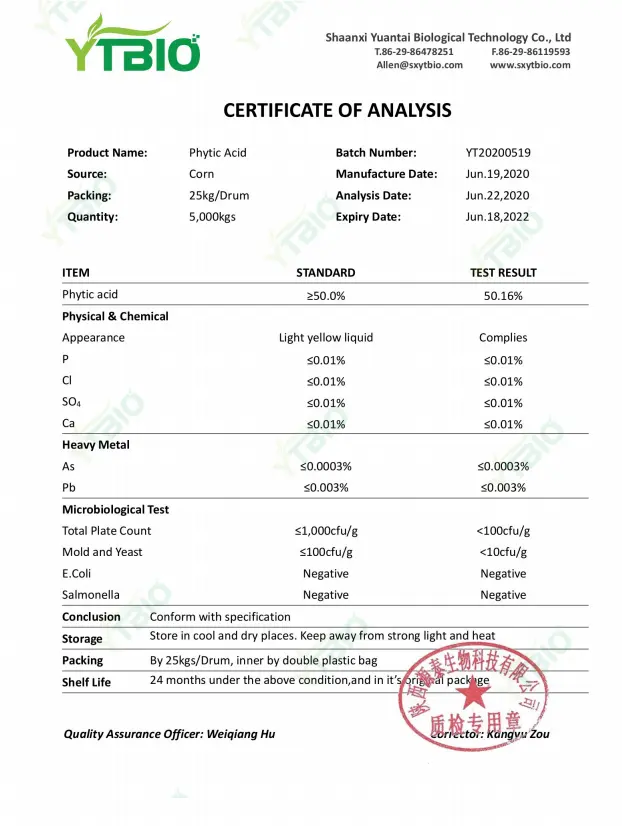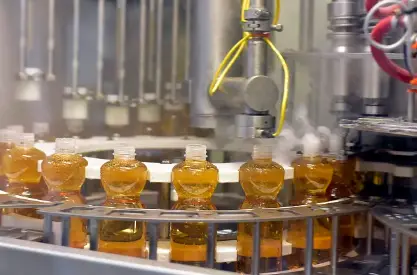IP6 Phytic Acid
Source: corn
Appearance: Colorless to light yellow liquid
Specifications: 50%
Detection method: HPLC
Shipping speed:1-3 days
Inventory:In stock
MOQ:25KG
Certificate:cGMP,ISO22000,ISO9001,EU&NOP Organic Certificate,Kosher,BRC,Halal,HACCP
- Fast Delievery
- Quality Assurance
- 24/7 Customer Service
Product Introduction
Do You Know What IP6 Phytic Acid Is?
IP6 Phytic acid, also known as "inositol hexaphosphate" or "IP6," is a compound found only in plant foods. It is primarily found in the seeds, roots, and stems of plants, with the highest concentrations found in legume seeds and the bran and germ of cereals. It is the primary storage form of phosphorus in plant seeds. During germination, phytic acid degrades and releases phosphorus for use by the young plant.


IP6 Phytic acid has a very strong chelating capacity. Simply put, chelating capacity refers to the ability to "capture" other structurally compatible components at the molecular level to form stable compounds. In daily diets, phytic acid often combines with minerals such as calcium, magnesium, zinc, potassium, and iron, forming insoluble salts, which significantly reduces the nutritional availability of these trace minerals.
Phytic acid has a strong chelating ability and is widely used in the chemical, medical, and food industries. In the food industry, it is particularly used in oily foods, alcoholic beverages, canned beverages, aquatic products, and fresh fruits and vegetables as an antioxidant, stabilizer, colorant, and preservative. Studies have shown that phytic acid also has certain anti-aging effects and is a safe, multifunctional new food additive extracted from natural plants.
YTBIO: Providing You With High-quality IP6 Phytic Acid

Characteristics of IP6 Phytic Acid
1. Phytic acid is a light yellow liquid or brown slurry. It occurs naturally in plants, one form of which is the calcium, magnesium, or potassium salt of phytic acid (phytic acid).
2. Phytic acid is widely found in the plant kingdom, such as rice bran, wheat bran, vegetables, and many plant seeds. It is also present in the nucleated red blood cells of some animals, where it promotes the release of oxygen from oxyhemoglobin.
3. Solubility and Stability of Phytic Acid
Phytic acid is readily soluble in water, 95% ethanol, glycerol, and acetone. It is relatively stable when heated below 120°C for a short time or at high concentrations.
pH of phytic acid aqueous solutions The pH value varies with its concentration. For example, at a concentration of 1.3%, the pH value is 0.4, while at a concentration of 0.7%, the pH value is 1.7.
Phytic acid is very stable to light and very sensitive to yeast, making it easily destroyed by fermentation. It is also unstable to microorganisms and can be broken down by phytase into inositol and phosphate.
Mechanism of Action of IP6 Phytic Acid
Phytic acid, through its ability to highly complex metal ions, inhibits oxidation and browning reactions, promotes precipitation, and mitigates the negative effects of these reactions on food, ultimately achieving the goal of preserving food freshness.
Chelating Effect of IP6 Phytic Acid
Phytic acid has a strong chelating ability, the strength of which depends on the type of metal ion. Phytic acid has 12 acid groups and can chelate metal ions to form insoluble metal salts. The higher the concentration, the more stable it is. At a pH of 6-7, it can form stable chelates with almost all multivalent cations. Phytic acid's chelating effect prevents the absorption of toxic metals in the body. It inhibits calcium phosphate and can help prevent tooth decay, but it easily decomposes when heated. Phytic acid has a strong chelating effect on heavy metal ions, similar to that of EDTA, but with a wider range of applications. Phytic acid's chelating effect prevents the absorption of toxic metals in the digestive tract, inhibits calcium phosphate, and can help prevent tooth decay.
Applications of IP6 Phytic Acid
Food
Phytic acid is used as a green, natural preservative, antibacterial agent, stabilizer in the brewing industry, fermentation promoter, metal ion chelator, and color stabilizer for canned foods.
Daily Chemical Industry
Phytic acid has certain whitening and moisturizing properties and is primarily used in products such as toothpaste, cosmetics, and shower gels.
Chemical Industry
IP6 Phytic acid can be used as an anti-sticking agent for polyvinyl chloride (PVC) polymerization reactors and as a metal surface treatment agent.
Wide Range Of Uses Of IP6 Phytic Acid In The Food Industry
Antioxidant Effects of IP6 Phytic Acid
Phytic acid can prevent rusting of metal bottle caps, prevent browning or discoloration in foods, and stabilize vitamin C. Phytic acid is used as an antioxidant and stabilizer. For example, in seasonings for pickled foods or braised fish and shrimp, adding 0.1%-0.3% phytic acid during the production process can prevent browning or discoloration. Phytic acid can significantly reduce iron-catalyzed oxidation in sample systems and partially inhibit iron-catalyzed vitamin C oxidation.
Phytic Acid in Food Processing There are two main applications for phytic acid: first, as an antioxidant in oils and fats. Adding 0.01% to vegetable oils significantly prevents rancidity. Second, for aquatic products:
① Preventing the formation of magnesium ammonium phosphate
② Preventing canned shellfish from turning black. When canned shellfish are heated, hydrogen sulfide and other substances are produced. These react with the iron and steel in the meat and the iron and tin on the can surface to form sulfides, causing the can to turn black. Adding 0.1%-0.5% phytic acid can prevent this.
③ Preventing blue spots on canned meat
④ Preventing fresh shrimp from turning black.
Effects of IP6 Phytic Acid Use
Phytic acid is used as an antioxidant in vegetable oils. For example, adding 0.01% to vegetable oils like soybean oil is very effective. It can be used to preserve fruits and vegetables, and has shown significant results in tests with cucumbers, tomatoes, and bananas.
1.The optimal phytic acid concentration is around 1%. Lower concentrations result in poor results.
2.Concentrations above 2% are highly acidic, causing significant pH changes on the surface of fruits and vegetables, resulting in suboptimal results.
Phytic acid is one of the most effective agents in foods that inhibit iron-catalyzed lipid oxidation. In meat products, it scavenges myoglobin-derived iron from negatively charged phospholipids, preventing auto-oxidation and the development of off-flavors. When stored at 4°C, it inhibits oxygen absorption, malonyldiacetaldehyde formation, and the development of rancid odors in sealed cooked chicken breast. It also has a similar effect on cooked beef.



IP6 Phytic Acid as a Color Preservative in Foods
Enzymatic and non-enzymatic browning are two major challenges in the processing and storage of fruits and vegetables. Phytic acid, as an additive, can effectively slow or prevent these reactions, protecting the color.
Phytic acid is effective in preventing browning in apple juice and protecting the color of spinach juice during processing. Adding a small amount of phytic acid to foods like bread and salad can enhance the stability of natural and synthetic pigments. Browning and mold growth can cause pickles to discolor, lose vitamins, and damage their structure, reducing their quality and nutritional value, and even producing harmful substances. Therefore, color protection and mold prevention are key issues in pickle production. Research has demonstrated that adding 0.2% phytic acid to a preservative solution has excellent anti-browning and mold prevention effects on pickled mustard greens, both in the presence and absence of oxygen.
IP6 Phytic Acid as a Precipitant in Foods
IP6 Phytic acid contains six molecules of phosphate in its structure. When fully dissociated, it is highly negatively charged and can form insoluble chelates with divalent and trivalent cations. The alkaline phosphate groups can bind to protonated amino acids in proteins to form insoluble complexes, effectively removing solids from solutions.
In the production of low-alcohol liquor, as the base liquor is reduced in alcohol content, the precipitation of alcohol-soluble substances in the liquor causes turbidity. Analysis shows that the main cause of turbidity is the precipitation of higher fatty acid ethyl esters, such as ethyl palmitate, ethyl oleate, and ethyl linoleate, as their solubility decreases with decreasing alcohol content. Turbidity is more severe when the water used for blending is hard and contains high levels of metal salts. These salts, along with other non-volatile substances, contribute to the solids content of the liquor. High levels of non-volatile matter in the liquor can lead to excessive solids content. Currently, there are many methods for addressing turbidity in low-alcohol liquor, including starch, activated carbon, resin adsorption, and membrane filtration technologies such as microfiltration, ultrafiltration, and molecular sieves. However, while addressing turbidity, these methods also reduce the aroma and flavor components in the liquor to varying degrees, disrupting the balance between the various flavor compounds in the liquor. This affects the taste and harmony of the liquor, resulting in a "bland" or "watery" flavor.
Utilizing the properties of phytic acid, it removes metal ions from the liquor, inhibiting their flocculation-promoting effect on higher fatty acid esters and increasing their solubility in the liquor. This addresses the turbidity issue in low-alcohol liquor, while minimizing the loss of aroma compounds and significantly reducing the solids content. It is an ideal method for turbidity and solids reduction.
The Skincare Benefits and Effects of IP6 Phytic Acid
Phytic acid has similar benefits to kojic acid in skincare products, inhibiting tyrosinase activity in the body and thus controlling skin pigmentation. However, because phytic acid is plant-derived and edible, it has a lower allergenic potential and offers relatively safe antioxidant and whitening properties, making it an ideal alternative to kojic acid.
Phytic acid has been used as a skin-whitening agent since early 1995. Its mechanism of action is to block the role of iron and copper in melanin formation. This antioxidant effect is crucial for the skin, helping to protect it from sun damage while brightening dull complexions. Consequently, phytic acid is used in a variety of packaged foods. Phytate's antioxidant properties can prevent seeds from rotting and spoiling, and the food industry often uses phytic acid as a preservative to prevent food spoilage.
Phytic acid's antioxidant and anti-free radical effects stem from its chelating properties. Most natural oxidation processes require metal ions as catalysts, generating highly reactive free radicals. By chelating iron ions, phytic acid not only reduces free radical production but also slows down the oxidative reaction while remaining relatively stable. These benefits of phytic acid have been recognized by the cosmetics industry, leading to its increasing popularity in recent years. Phytic acid also acts as a mild exfoliant, more gentle than other acids like folic acid at the same pH. It binds to and softens calcium within pores, temporarily helping to reduce their appearance. Studies have also shown that phytic acid can reduce inflammation, making it an ideal choice for those with sensitive skin or rosacea.
As a professional IP6 phytic acid manufacturer and supplier, YTBIO is committed to providing high-quality IP6 phytic acid to every customer. We have a professional team and our own production facility. If you have any questions or inquiries, please contact us and we will respond as soon as possible.
_1737093401309.png)

